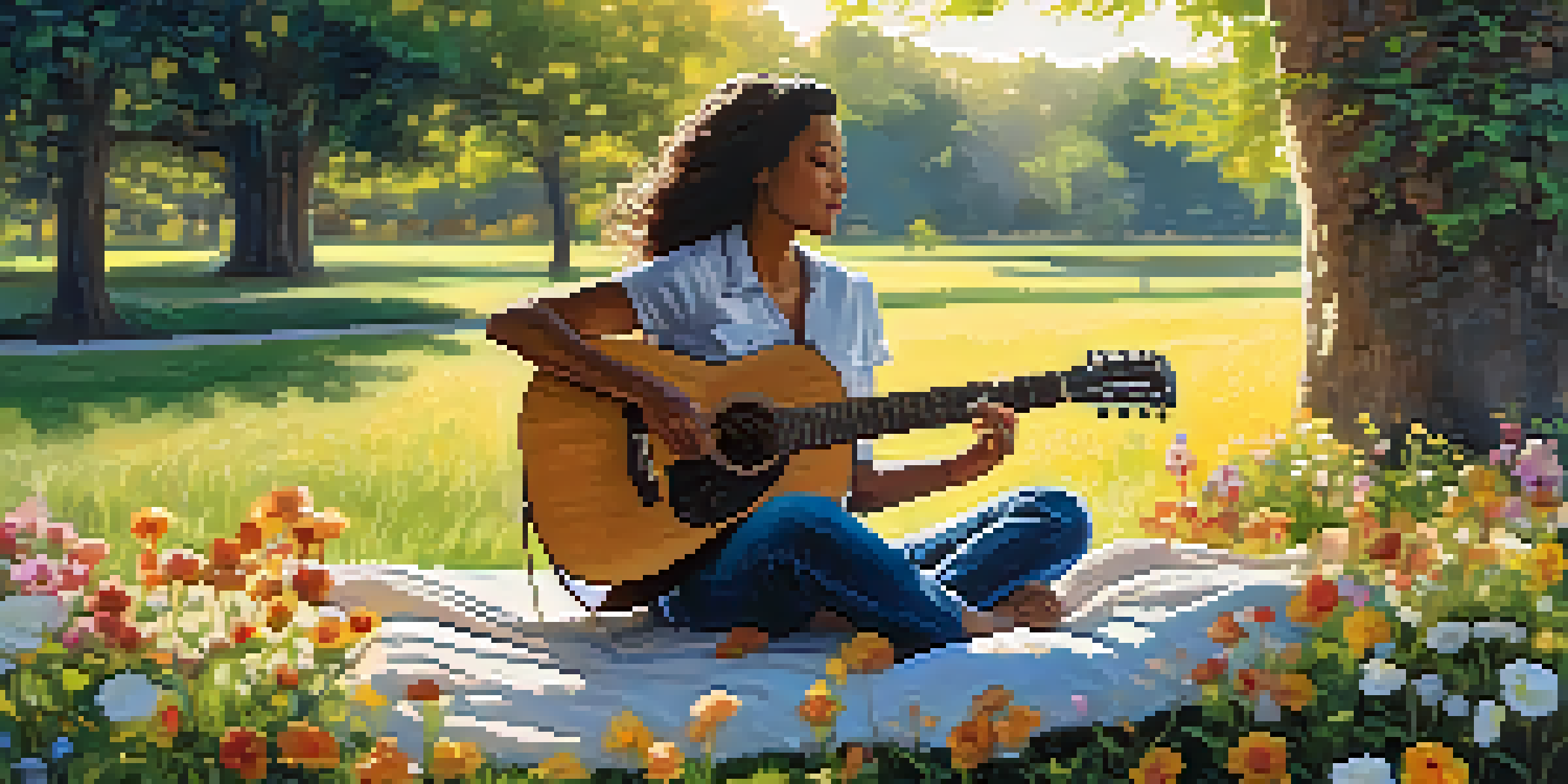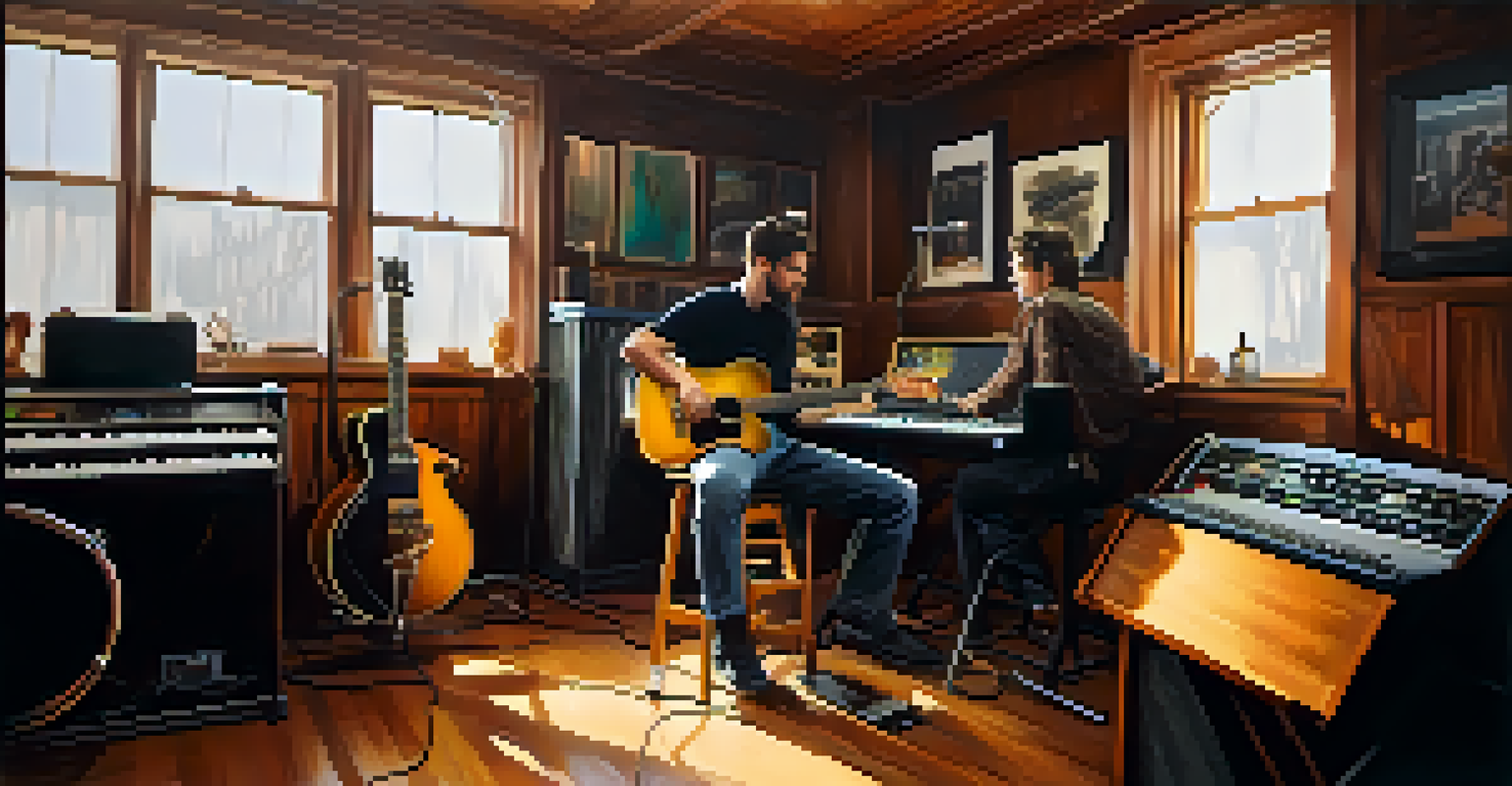Guitarists and Vocalists: The Art of Musical Collaboration

The Magic of Collaboration in Music
Collaboration in music is like a beautiful dance between two partners. When guitarists and vocalists come together, they create a synergy that enhances the emotional depth of a song. This partnership allows each artist to shine while supporting the other, resulting in a richer musical experience.
Alone we can do so little; together we can do so much.
Think of it as a conversation where each party brings their own perspective and skills to the table. A guitarist's riffs can inspire a vocalist's melody, while the emotional weight of lyrics can influence a guitarist's playing style. It's this back-and-forth that transforms simple notes and words into something profoundly moving.
As they work together, guitarists and vocalists often discover new aspects of their artistry. They learn from one another, pushing each other to explore different genres, techniques, and styles. This collaborative spirit not only fuels creativity but also fosters a sense of camaraderie that can last a lifetime.
Communication: The Key to Successful Collaboration
Effective communication is crucial for any successful musical collaboration. Guitarists and vocalists must be able to express their ideas clearly and listen to one another's feedback. This open dialogue helps to avoid misunderstandings and ensures that both parties are on the same page.

For instance, a vocalist may have a specific emotion they want to convey in a song, which can guide the guitarist in crafting the perfect accompaniment. Similarly, a guitarist might experiment with different chord progressions that inspire the vocalist to adapt their melody. This fluid exchange of ideas can lead to innovative and unexpected outcomes.
Collaboration Enhances Musical Depth
The partnership between guitarists and vocalists creates a richer emotional experience through shared creativity and support.
Moreover, non-verbal cues play a significant role in musical collaboration. Body language, eye contact, and even the energy in the room can inform each artist’s performance. By being attuned to these signals, both the guitarist and vocalist can elevate their partnership and create something truly special.
Finding the Right Balance Between Guitar and Vocals
Balance is essential when blending guitar and vocals. Too much of one can overshadow the other, leading to a disjointed sound. Guitarists must learn to play in a way that complements the vocalist's range, while vocalists should be mindful of their volume and intensity to ensure they don’t drown out the guitar.
The best way to predict the future is to create it.
A great example is the classic duet format, where both artists share the spotlight. Here, the guitarist may use softer strumming or fingerpicking during vocal sections and ramp up intensity during instrumental solos. This dynamic interplay creates a captivating listening experience for the audience.
Ultimately, achieving the right balance is about respect for each other's craft. When guitarists and vocalists recognize the importance of their roles and collaborate harmoniously, they can create music that resonates on a deeper level.
Harmonizing Melodies and Lyrics
Harmonizing is one of the most beautiful aspects of musical collaboration. When guitarists complement a vocalist's melody with harmonized chords or counter-melodies, it can elevate the emotional impact of a song. This technique allows both artists to showcase their strengths while enhancing the overall sound.
Consider how many iconic songs feature memorable harmonies between guitar and vocals. The blending of these elements creates a sonic tapestry that draws listeners in and evokes strong feelings. It's a powerful reminder of how collaboration can amplify an artist's message.
Communication Drives Success
Effective communication between artists fosters innovation and helps avoid misunderstandings, leading to a more successful collaboration.
Furthermore, harmonizing can also open doors to new creative possibilities. Both guitarists and vocalists can experiment with different harmonies, leading to unique interpretations of familiar songs. This exploration not only enriches their collaboration but also keeps the creative process fresh and exciting.
Exploring Genres Together
One of the most exciting aspects of the guitarist-vocalist partnership is the opportunity to explore different genres together. Each artist brings their unique influences and preferences, which can lead to innovative musical fusions. This exploration often results in fresh sounds that capture the audience's attention.
For example, a guitarist with a background in rock might team up with a vocalist who specializes in folk music. By blending their styles, they can create a unique sound that appeals to fans of both genres. This cross-pollination of influences can breathe new life into traditional forms and inspire creativity.
Moreover, experimenting with different genres encourages both musicians to step outside their comfort zones. This willingness to explore can lead to unexpected breakthroughs and help each artist grow as a musician. As they venture into uncharted territory, they can discover new dimensions of their artistry together.
Overcoming Creative Differences
Every collaboration comes with its challenges, and creative differences are no exception. Guitarists and vocalists may have varying visions for a song or different approaches to their craft. However, navigating these differences can lead to growth and stronger partnerships.
For instance, when a disagreement arises, it’s an opportunity for both artists to share their perspectives and find common ground. This process can lead to compromises that enhance the final product. By embracing these moments of tension, they can foster a deeper understanding of each other's artistry.
Exploring Genres Fuels Creativity
Collaborating across different musical genres allows artists to blend influences, resulting in fresh and innovative sounds.
Ultimately, overcoming creative differences is about collaboration and respect. When both parties are willing to listen and adapt, they can transform potential conflicts into powerful moments of artistic expression.
The Lasting Impact of Collaboration
The bond formed between guitarists and vocalists during collaboration often lasts beyond the music. Many successful partnerships lead to lifelong friendships, as they share experiences and memories that shape their artistry. This connection can influence their future projects and inspire even greater creativity.
Additionally, the impact of their collaboration can resonate with audiences long after the performance ends. Iconic duos and bands often leave a legacy that continues to inspire new generations of musicians. Their collaborative spirit sets a standard for aspiring artists who seek to create meaningful music.

In essence, the art of collaboration is a beautiful journey that extends far beyond the stage. It’s about connection, growth, and the shared love of music that brings people together.